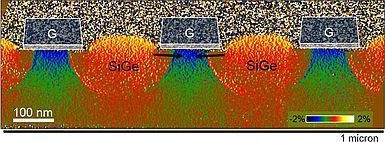Please type a search term (at least two characters)
News
EMRP project IND54 Nanostrain featured in New Scientist and The Telegraph

International science magazine New Scientist and UK newspaper The Telegraph feature the EMRP Nanostrain project in articles published in their latest issue and website respectively
As electronic devices grow more powerful, the demand they place on batteries increases. As a result new transistor materials that use less power thereby extending battery life are needed. Transistors made from piezoelectric materials, which change their shape in response to an applied voltage, could consume 100 times less power than those based on conventional materials. The Nanostrain project 'Novel electronic devices based on control of strain at the nanoscale' was set up to develop traceable measurements of strain at the nanoscale, to better understand how piezoelectric materials work and how they can be exploited.
The Nanostrain project has been mentioned in an article written for the latest issue of New Scientist on the plateauing of computer processing power. The New Scientist article describes the collaboration between European metrology institutions and industrial partners, including IBM, and quotes Markys Cain, Nanostrain coordinator. Markys says the project partners have demonstrated piezoelectric switching at a scale of 100 nanometres and they’re hoping to achieve results at even smaller length scales.
New Scientist is a UK-based weekly non-peer-reviewed English-language international science magazine which was founded more than 50 years ago and that reaches a global audience of over 3 million highly-engaged readers through its print and digital channels.
The Telegraph article features IBM’s work with Nanostrain project partners to ‘provide highly accurate measurements and a unique set of methodologies to help drive the commercialisation of next generation electronic devices’ based on piezoelectric materials. Applications could include ultra-high-speed and resolution printing, chemical and optical sensors, telecommunications, and innovative electronics in the automotive, power, oil and gas and medical sectors.
The website ‘telegraph.co.uk’ is the third most popular UK newspaper website, receiving nearly 4 million visitors every day.
Read the full article in The Telegraph and New Scientist
Find out more about EMRP project IND54 Nanostrain
.
Carbon dioxide, released from man-made activities, is lowering the pH of the Earth’s oceans, and impacting the health of marine organisms worldwide more
Supporting automated and reconfigurable manufacturing systems more
Working with external project Cool White to test and suggest improvements on the locally available white paints more
The project FutureEnergy has provided new calibration services for ultra-high voltages and a good practice guide on Lightning Impulse dividers more
For many of the 5000 photonics companies in Europe a precise knowledge of a material’s optical properties is vital for industrial competitiveness more





